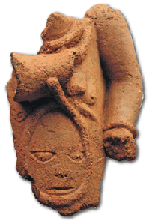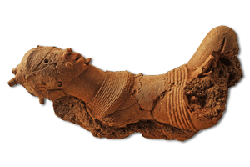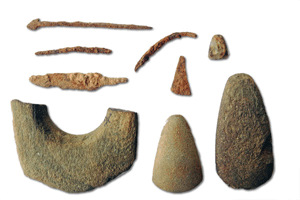Its worth the read, brehs
Unlocking the secrets of West Africa’s earliest known civilization
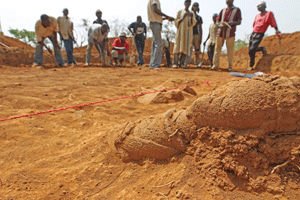
A terracotta head created by the Nok culture, one of ancient West Africa’s most advanced civilizations, emerges at a dig site near Janjala, Nigeria.
(Courtesy Peter Breunig)
In 1943, British archaeologist Bernard Fagg received a visitor in the central Nigerian town of Jos, where he had spent the previous few years gathering and classifying ancient artifacts found on a rugged plateau. The visitor carried a terracotta head that, he said, had been perched atop a scarecrow in a nearby yam field. Fagg was intrigued. The piece resembled a terracotta monkey head he had seen a few years earlier, and neither piece matched the artifacts of any known ancient African civilization.
Fagg, a man of boundless curiosity and energy, traveled across central Nigeria looking for similar artifacts. As he recounted later, Fagg discovered local people had been finding terracottas in odd places for years—buried under a hockey field, perched on a rocky hilltop, protruding from piles of gravel released by power-hoses in tin mining. He set up shop in a whitewashed cottage that still stands outside the village of Nok and soon gathered nearly 200 terracottas through purchase, persuasion, and his own excavations. Soil analysis from the spots where the artifacts were found dated them to around 500 B.C. This seemed impossible since the type of complex societies that would have produced such works were not supposed to have existed in West Africa that early. But when Fagg subjected plant matter found embedded in the terracotta to the then-new technique of radiocarbon dating, the dates ranged from 440 B.C. to A.D. 200. He later dated the scarecrow head—now called the Jemaa Head after the village where it was found—to about 500 B.C. using a process called thermoluminescence which gauges the time since baked clay was fired. Through a combination of luck, legwork, and new dating techniques, Fagg and his collaborators had apparently discovered a hitherto unknown civilization, which he named Nok.
One excavation site, near the village of Taruga, revealed something else Fagg had not expected: iron furnaces. He found 13 such furnaces, and terracotta figurines were in such close association—inside the furnaces and around them—that he postulated the terracottas were objects of worship to aid blacksmithing and smelting. Carbon dating of charcoal inside the furnaces revealed dates as far back as 280 B.C., giving Nok the earliest dates for iron smelting in sub-Saharan Africa up to that time. The high number of smelters and quantity of terracottas suggested he had found evidence of a dense, settled population.
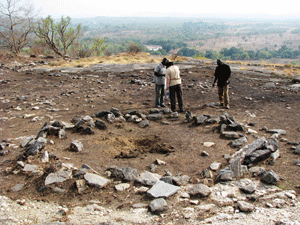
For more than 2,000 years since the start of the Nok period, Nigerians have been building stone house bases like this one.
(Courtesy Roger Atwood)
Thus, in short order, Fagg had discovered some of the key markers of an advanced civilization: refined art and organized worship, metal smelting, and sufficient population to support these activities. But he knew such a society did not appear in isolation. Fagg, now back at Oxford University in England, wrote that Nok culture had almost certainly begun earlier and survived longer than he had evidence for at the time. “It was the product of a mature tradition,” he wrote, “with the probability of a long antecedent history, of which as yet, no trace has been found.”
After 40 years of doing little archaeological exploration in the area, scholars are now returning to the scrubby, hilly lands where Fagg worked and are finding that, indeed, the Nok thrived for longer than he had realized. They may have been the first complex civilization in West Africa, existing from at least 900 B.C. to about A.D. 200. Their terracottas are now some of the most iconic ancient objects from Africa. And they may be the first society in Africa south of the Sahara to smelt iron, although at least half a dozen competitors for that title have surfaced since Fagg first excavated a Nok furnace.
Nigeria has a reputation for chaos, corruption, and expensive visas that has kept archaeologists away and drastically slowed the pace of research. In 1959, anthropologist George Murdock quipped that for every ton of earth moved by archaeologists on the Nile, a teaspoon is moved on the Niger. Scholarship has also been hampered by an almost 40-year campaign of looting at Nok sites fed by the growing appetite for African antiquities among collectors in the United States and Europe.
“No one continued with the work of Bernard Fagg. Instead of scientific exploration, the Nok became a victim of illegal digging and international art dealers,” says Peter Breunig, of the Johann Wolfgang Goethe University in Frankfurt, Germany. Looting tapered off after about 2005 because of tighter export restrictions and a glut of fakes that frightened off collectors. Now, interest in Iron Age societies in Africa is surging as archaeologists contemplate a wide-open field that could hold essential insights into how technologies—especially iron—spread across continents.

Unlocking the secrets of West Africa’s earliest known civilization

A terracotta head created by the Nok culture, one of ancient West Africa’s most advanced civilizations, emerges at a dig site near Janjala, Nigeria.
(Courtesy Peter Breunig)
In 1943, British archaeologist Bernard Fagg received a visitor in the central Nigerian town of Jos, where he had spent the previous few years gathering and classifying ancient artifacts found on a rugged plateau. The visitor carried a terracotta head that, he said, had been perched atop a scarecrow in a nearby yam field. Fagg was intrigued. The piece resembled a terracotta monkey head he had seen a few years earlier, and neither piece matched the artifacts of any known ancient African civilization.
Fagg, a man of boundless curiosity and energy, traveled across central Nigeria looking for similar artifacts. As he recounted later, Fagg discovered local people had been finding terracottas in odd places for years—buried under a hockey field, perched on a rocky hilltop, protruding from piles of gravel released by power-hoses in tin mining. He set up shop in a whitewashed cottage that still stands outside the village of Nok and soon gathered nearly 200 terracottas through purchase, persuasion, and his own excavations. Soil analysis from the spots where the artifacts were found dated them to around 500 B.C. This seemed impossible since the type of complex societies that would have produced such works were not supposed to have existed in West Africa that early. But when Fagg subjected plant matter found embedded in the terracotta to the then-new technique of radiocarbon dating, the dates ranged from 440 B.C. to A.D. 200. He later dated the scarecrow head—now called the Jemaa Head after the village where it was found—to about 500 B.C. using a process called thermoluminescence which gauges the time since baked clay was fired. Through a combination of luck, legwork, and new dating techniques, Fagg and his collaborators had apparently discovered a hitherto unknown civilization, which he named Nok.
One excavation site, near the village of Taruga, revealed something else Fagg had not expected: iron furnaces. He found 13 such furnaces, and terracotta figurines were in such close association—inside the furnaces and around them—that he postulated the terracottas were objects of worship to aid blacksmithing and smelting. Carbon dating of charcoal inside the furnaces revealed dates as far back as 280 B.C., giving Nok the earliest dates for iron smelting in sub-Saharan Africa up to that time. The high number of smelters and quantity of terracottas suggested he had found evidence of a dense, settled population.

For more than 2,000 years since the start of the Nok period, Nigerians have been building stone house bases like this one.
(Courtesy Roger Atwood)
Thus, in short order, Fagg had discovered some of the key markers of an advanced civilization: refined art and organized worship, metal smelting, and sufficient population to support these activities. But he knew such a society did not appear in isolation. Fagg, now back at Oxford University in England, wrote that Nok culture had almost certainly begun earlier and survived longer than he had evidence for at the time. “It was the product of a mature tradition,” he wrote, “with the probability of a long antecedent history, of which as yet, no trace has been found.”
After 40 years of doing little archaeological exploration in the area, scholars are now returning to the scrubby, hilly lands where Fagg worked and are finding that, indeed, the Nok thrived for longer than he had realized. They may have been the first complex civilization in West Africa, existing from at least 900 B.C. to about A.D. 200. Their terracottas are now some of the most iconic ancient objects from Africa. And they may be the first society in Africa south of the Sahara to smelt iron, although at least half a dozen competitors for that title have surfaced since Fagg first excavated a Nok furnace.
Nigeria has a reputation for chaos, corruption, and expensive visas that has kept archaeologists away and drastically slowed the pace of research. In 1959, anthropologist George Murdock quipped that for every ton of earth moved by archaeologists on the Nile, a teaspoon is moved on the Niger. Scholarship has also been hampered by an almost 40-year campaign of looting at Nok sites fed by the growing appetite for African antiquities among collectors in the United States and Europe.
“No one continued with the work of Bernard Fagg. Instead of scientific exploration, the Nok became a victim of illegal digging and international art dealers,” says Peter Breunig, of the Johann Wolfgang Goethe University in Frankfurt, Germany. Looting tapered off after about 2005 because of tighter export restrictions and a glut of fakes that frightened off collectors. Now, interest in Iron Age societies in Africa is surging as archaeologists contemplate a wide-open field that could hold essential insights into how technologies—especially iron—spread across continents.
